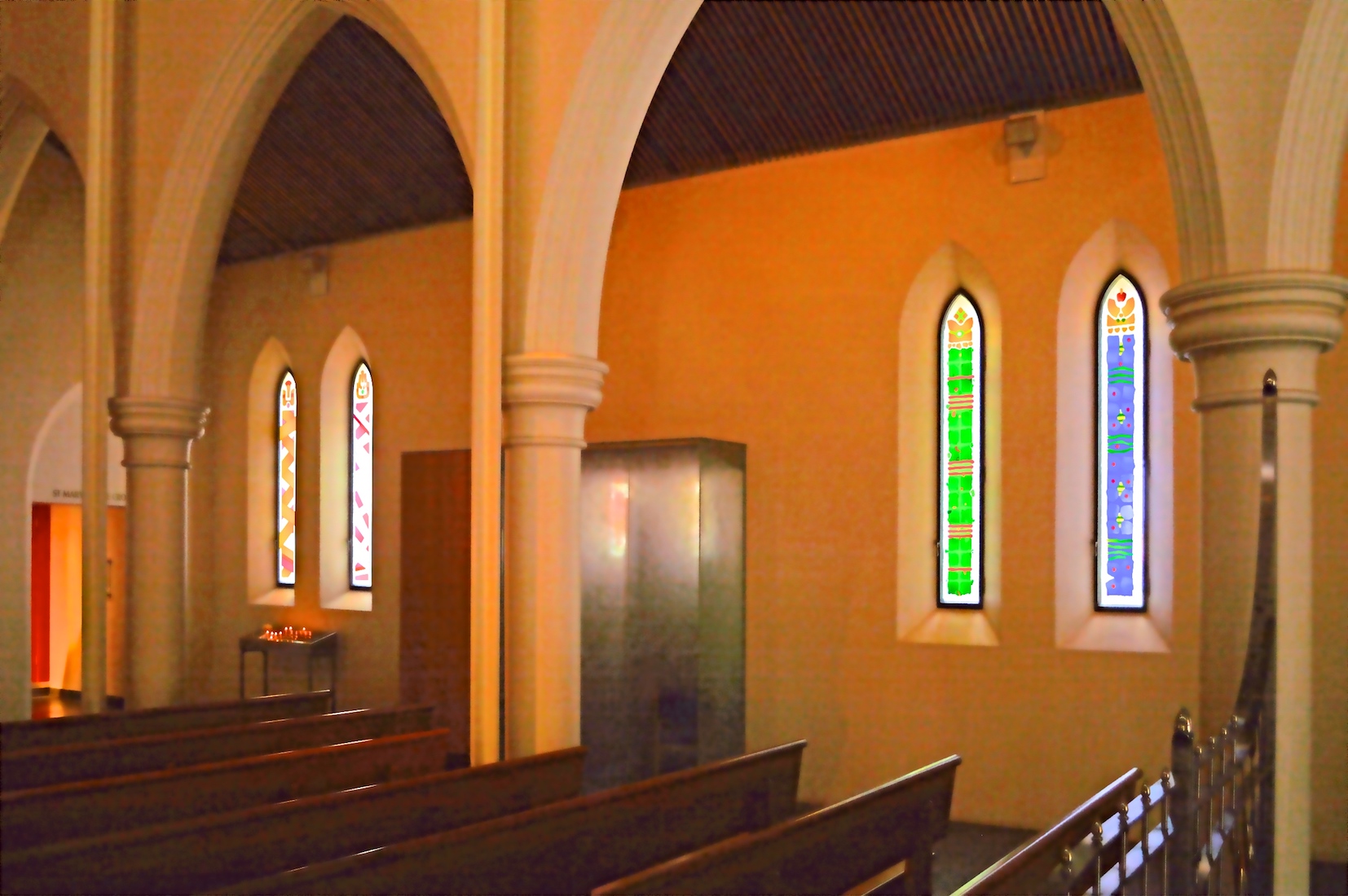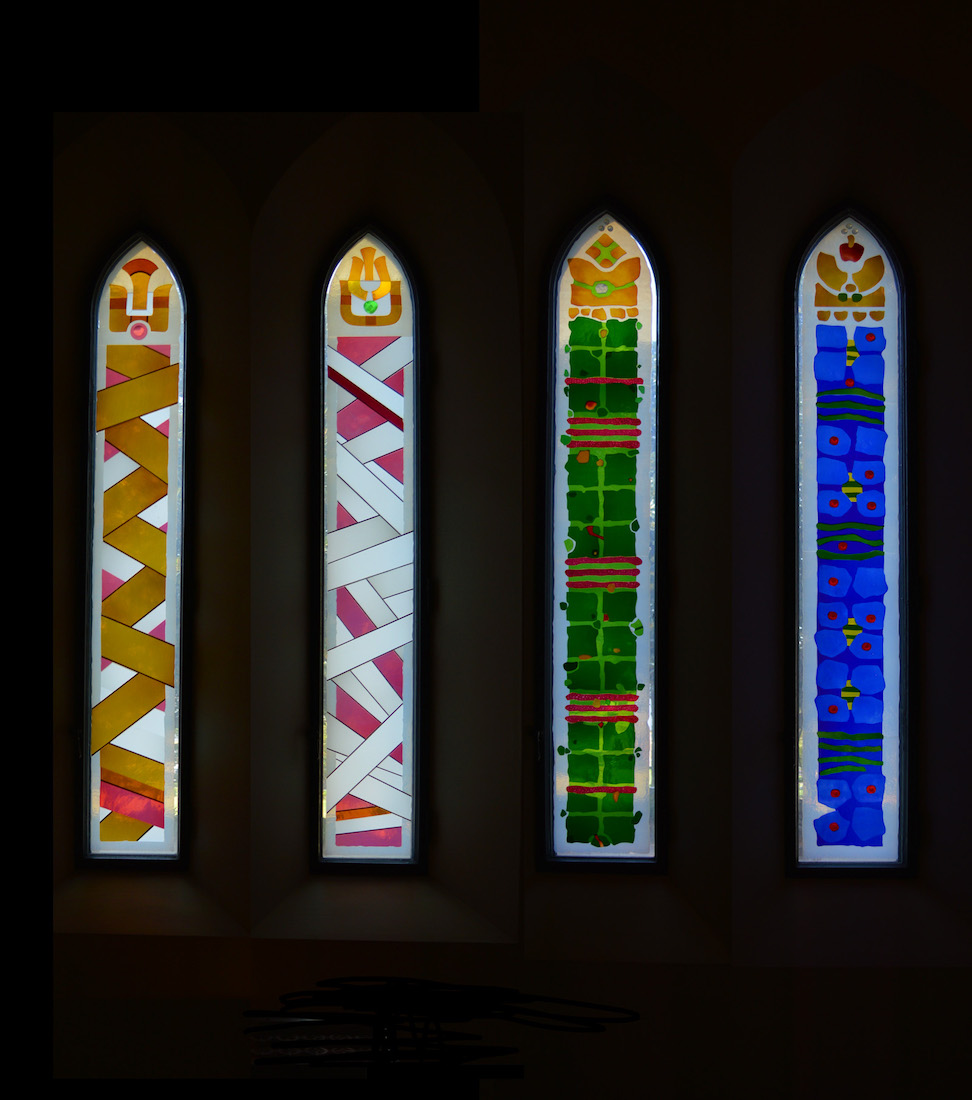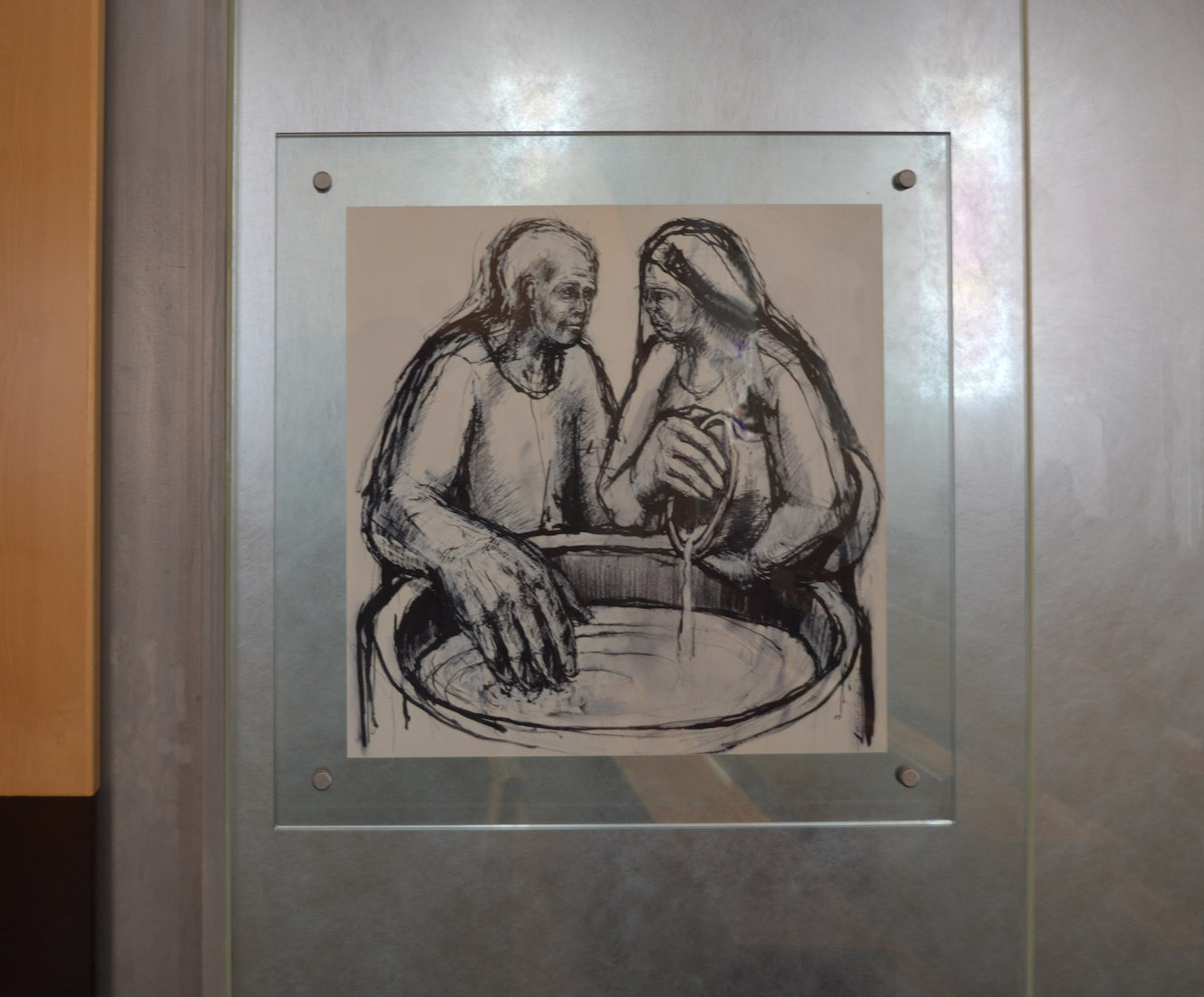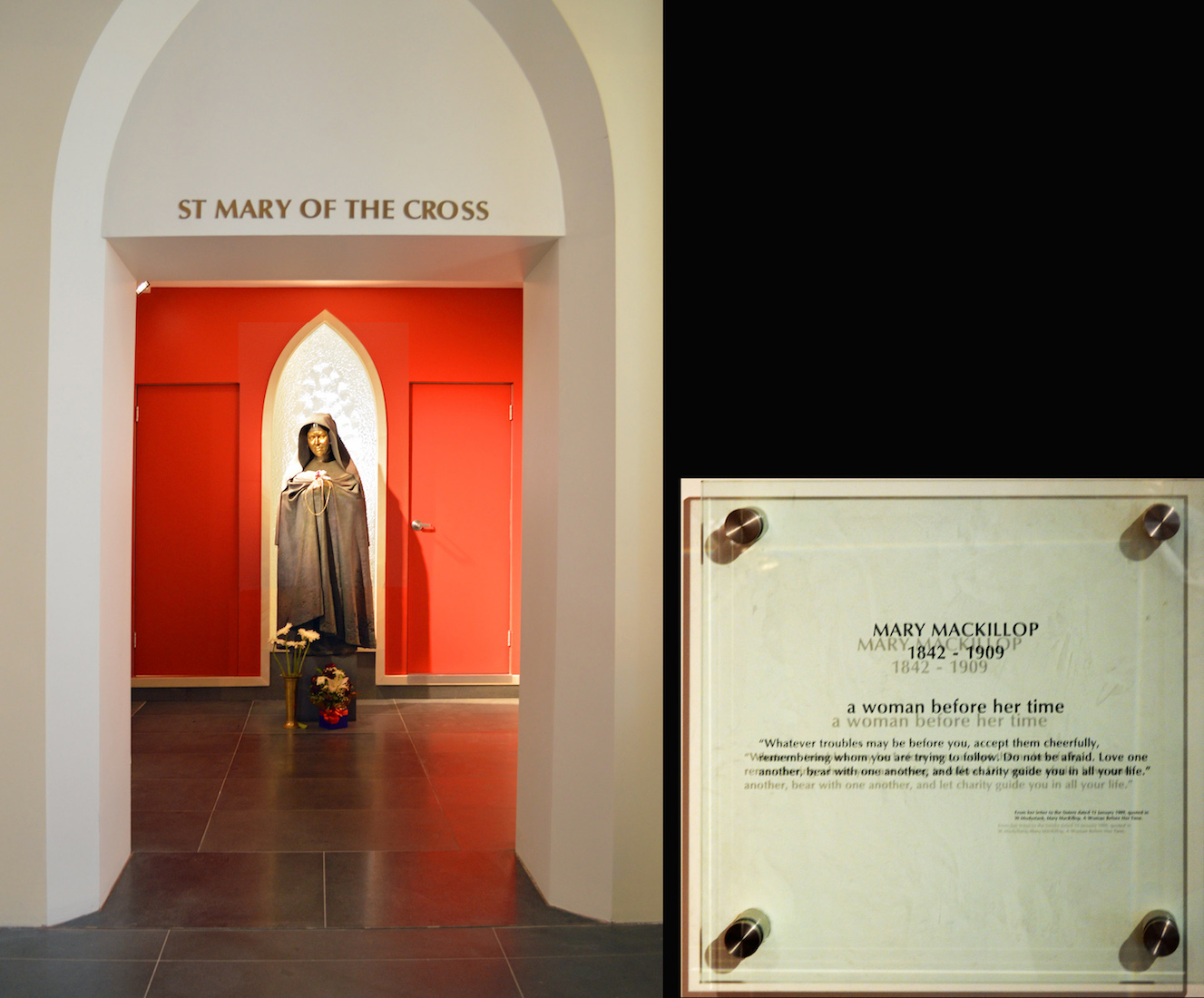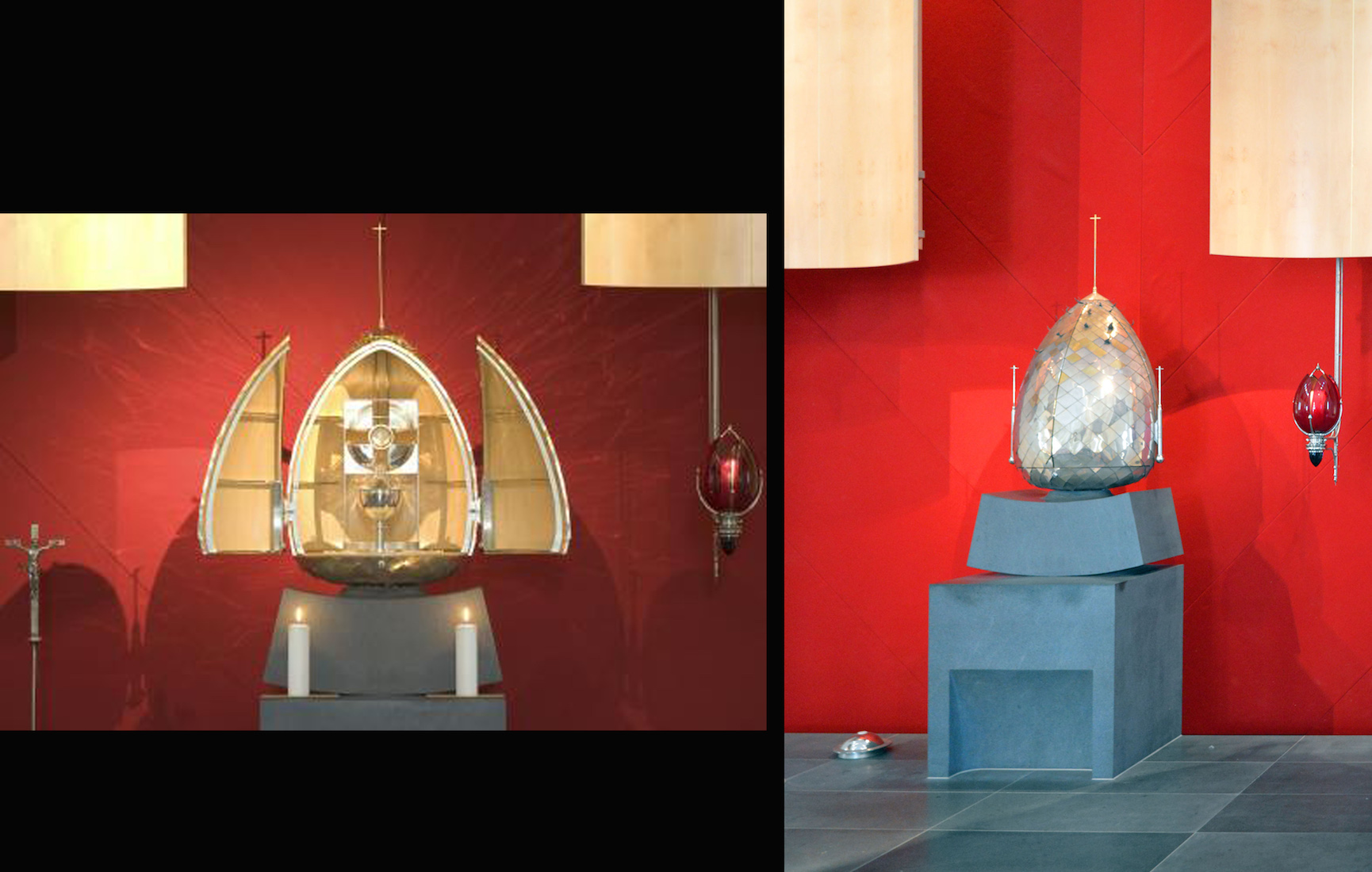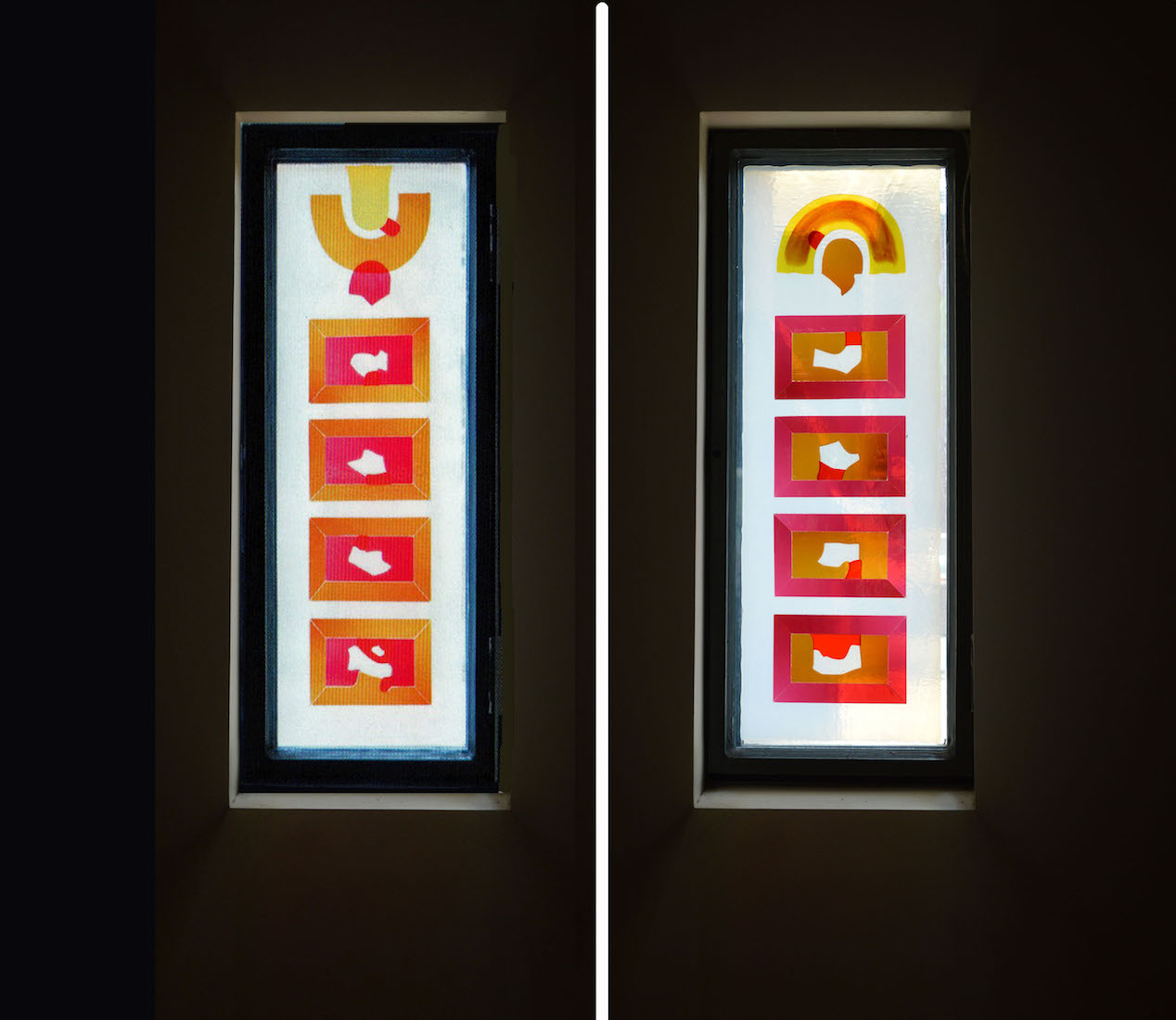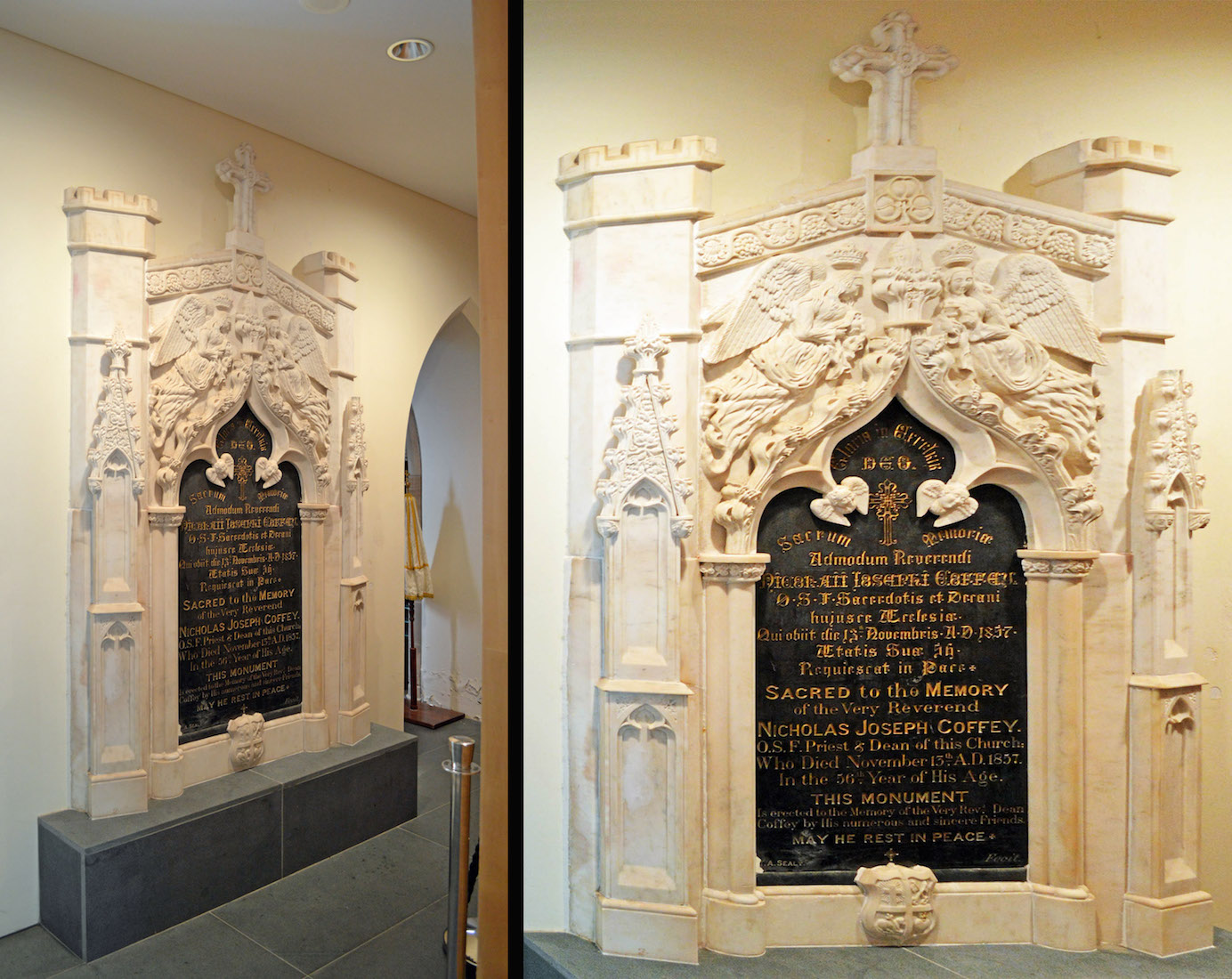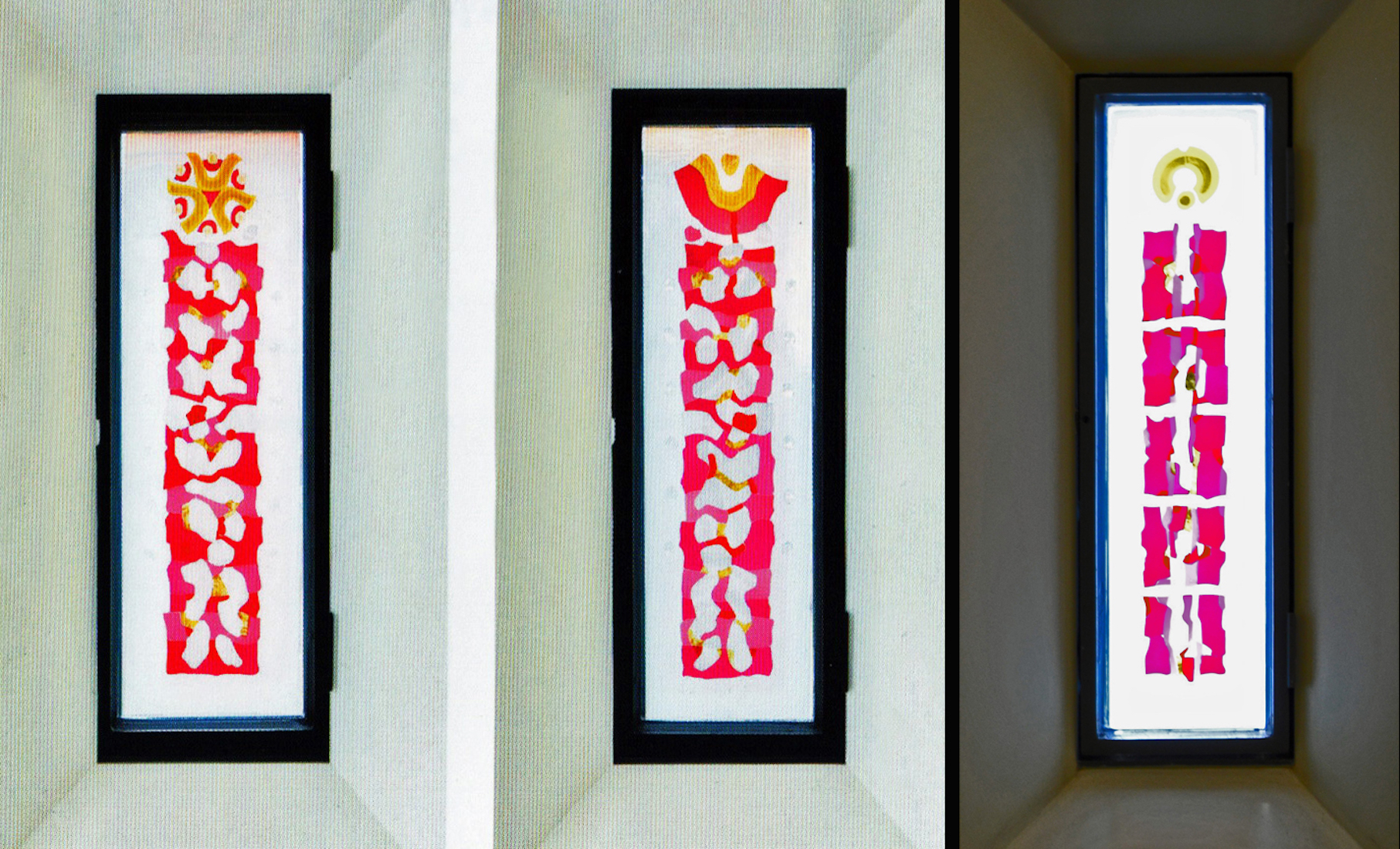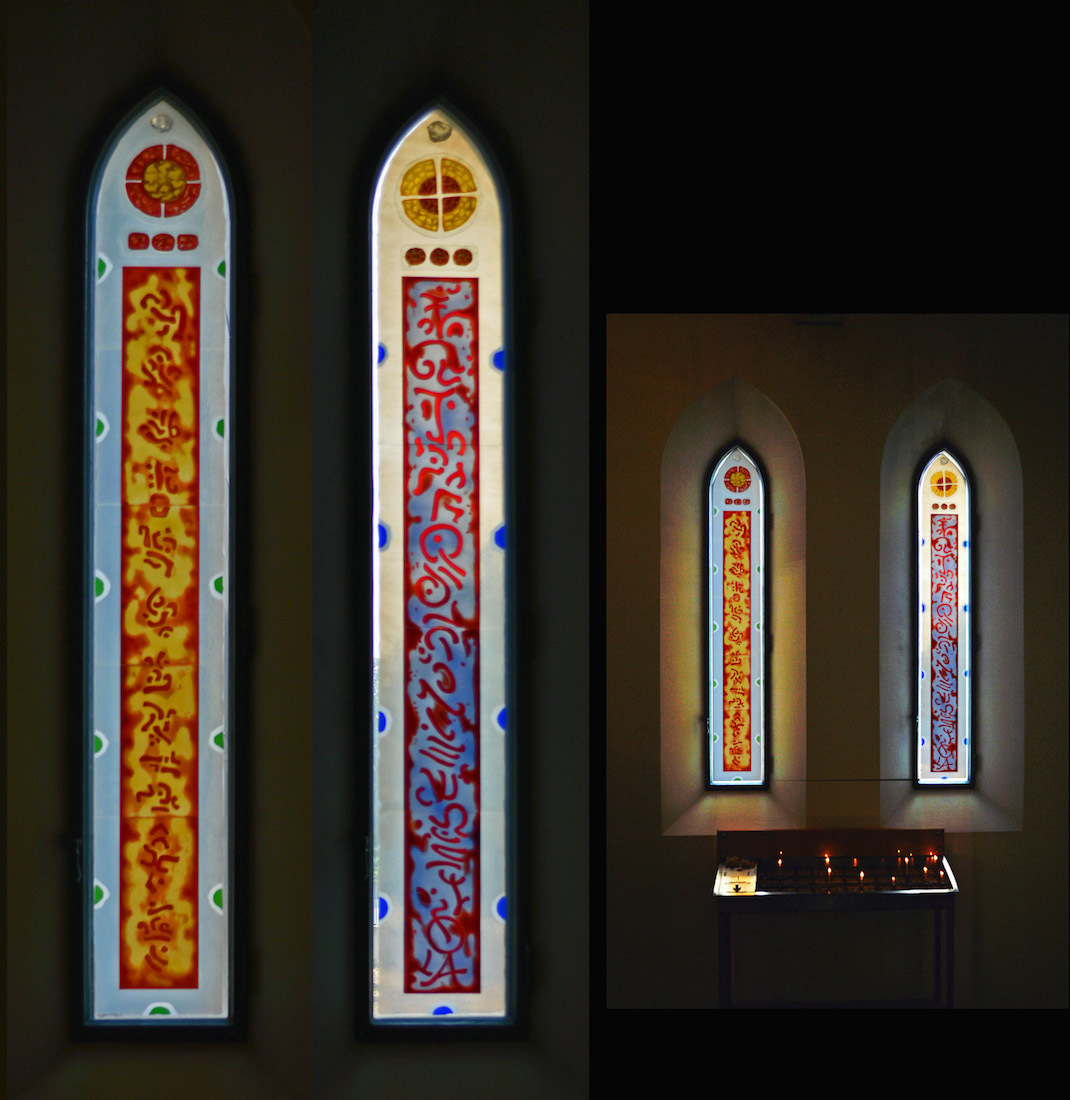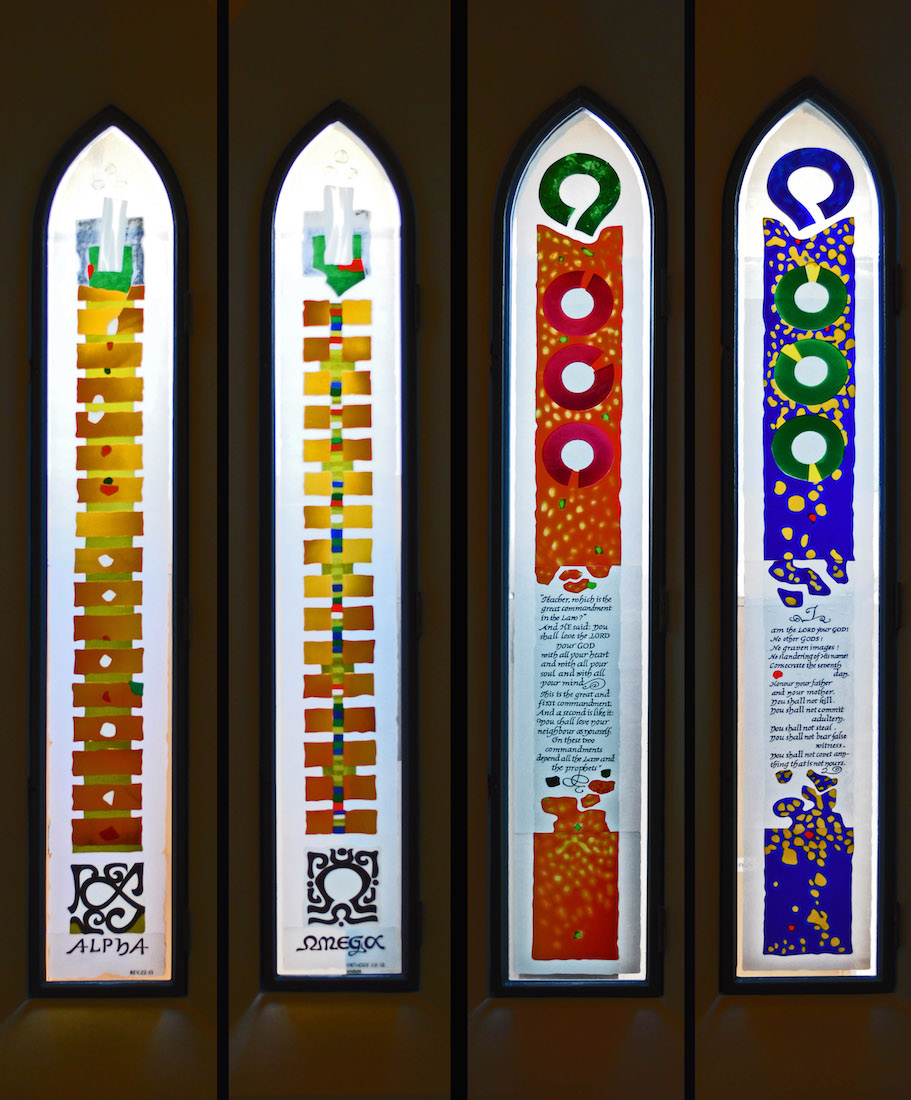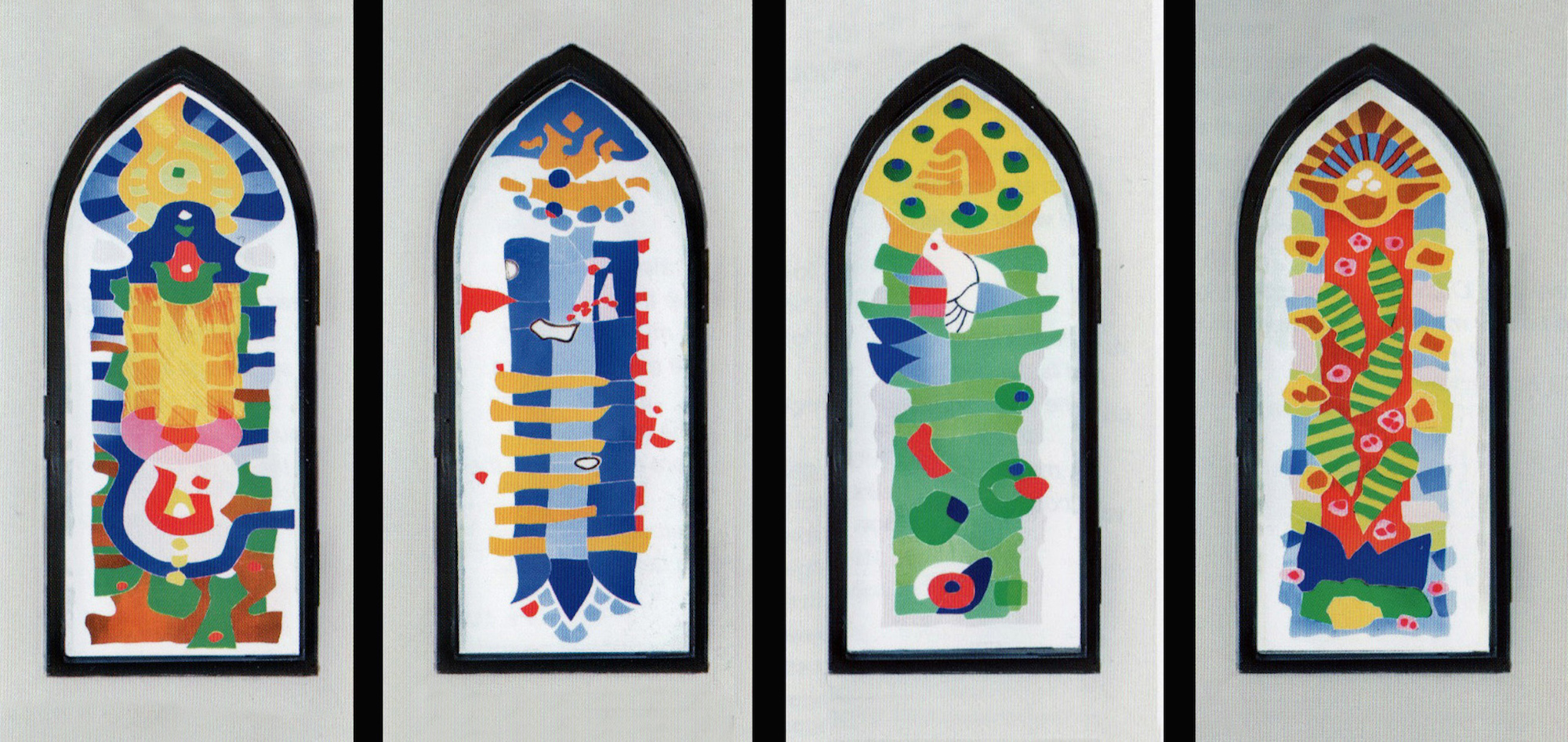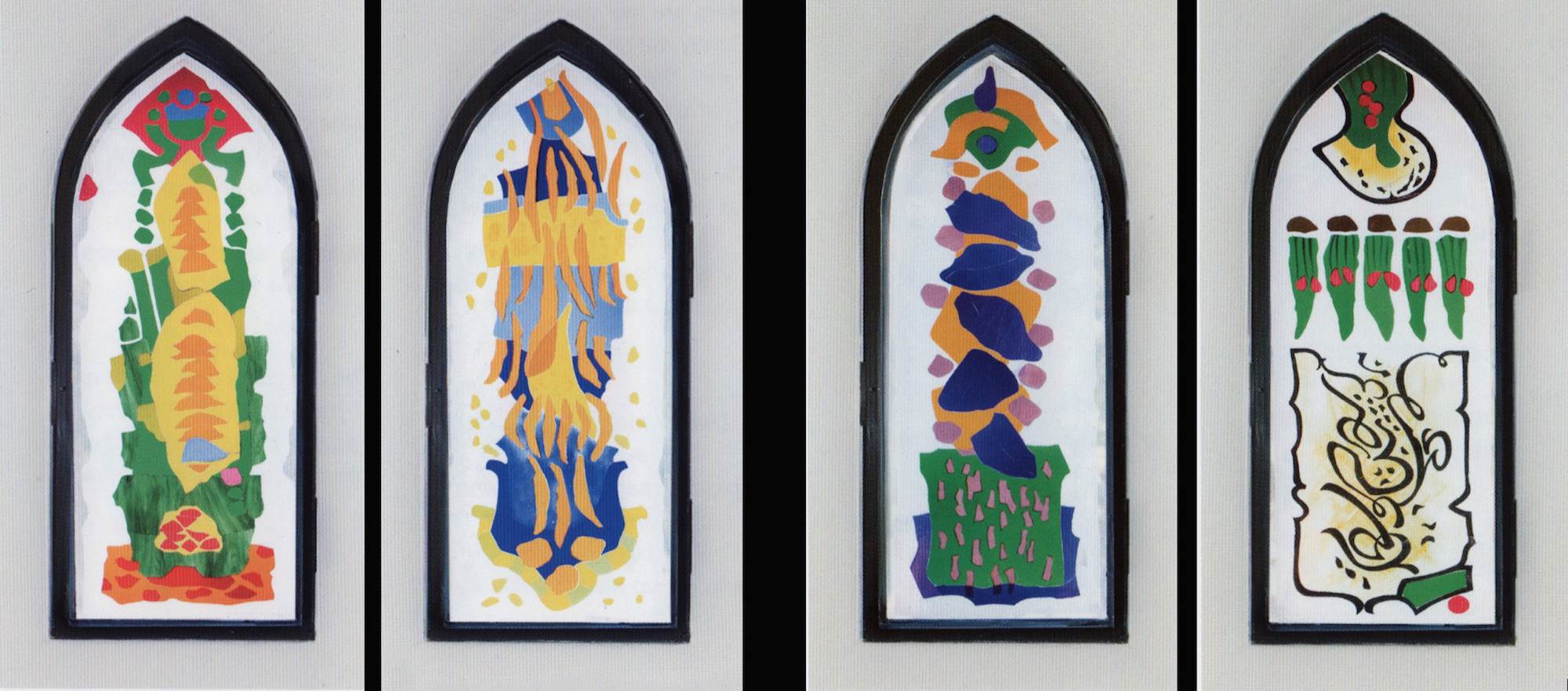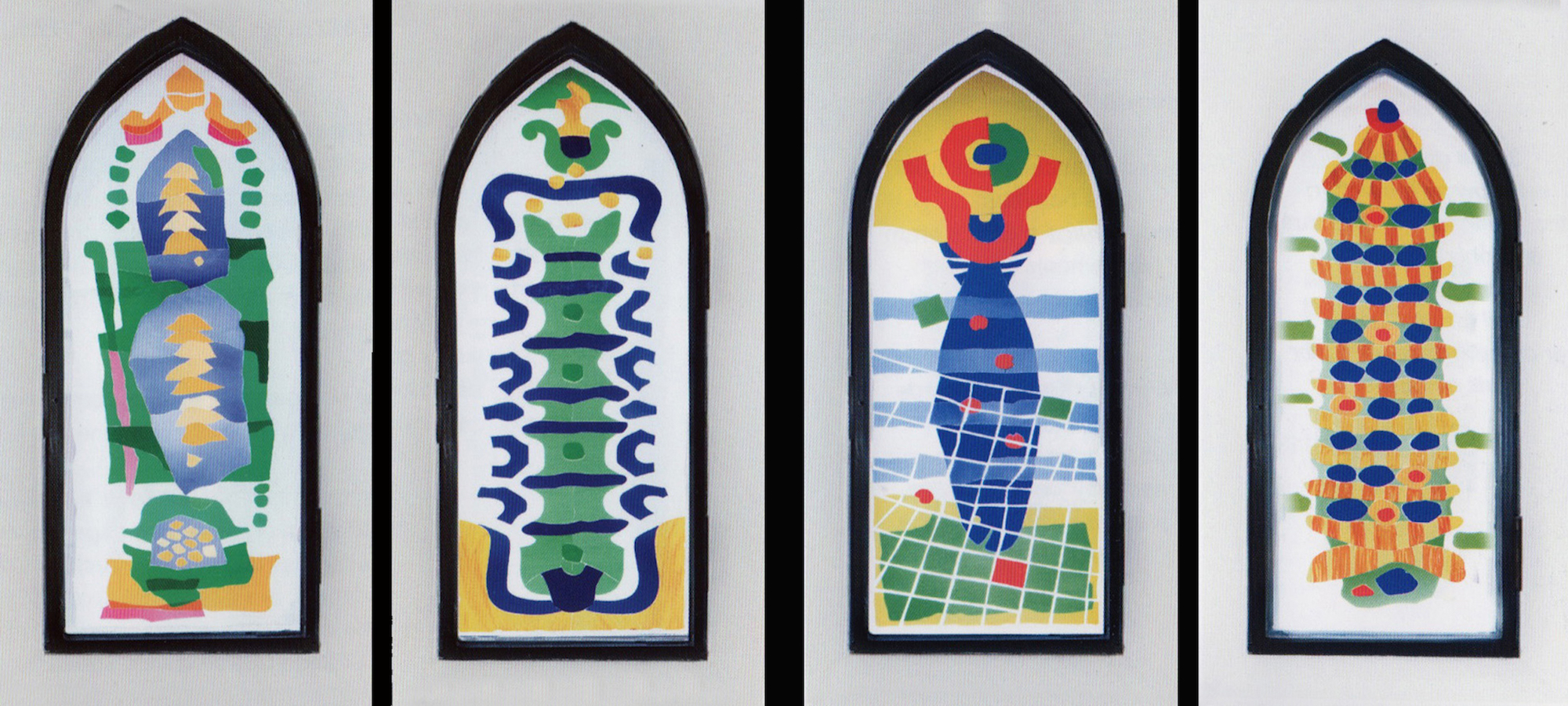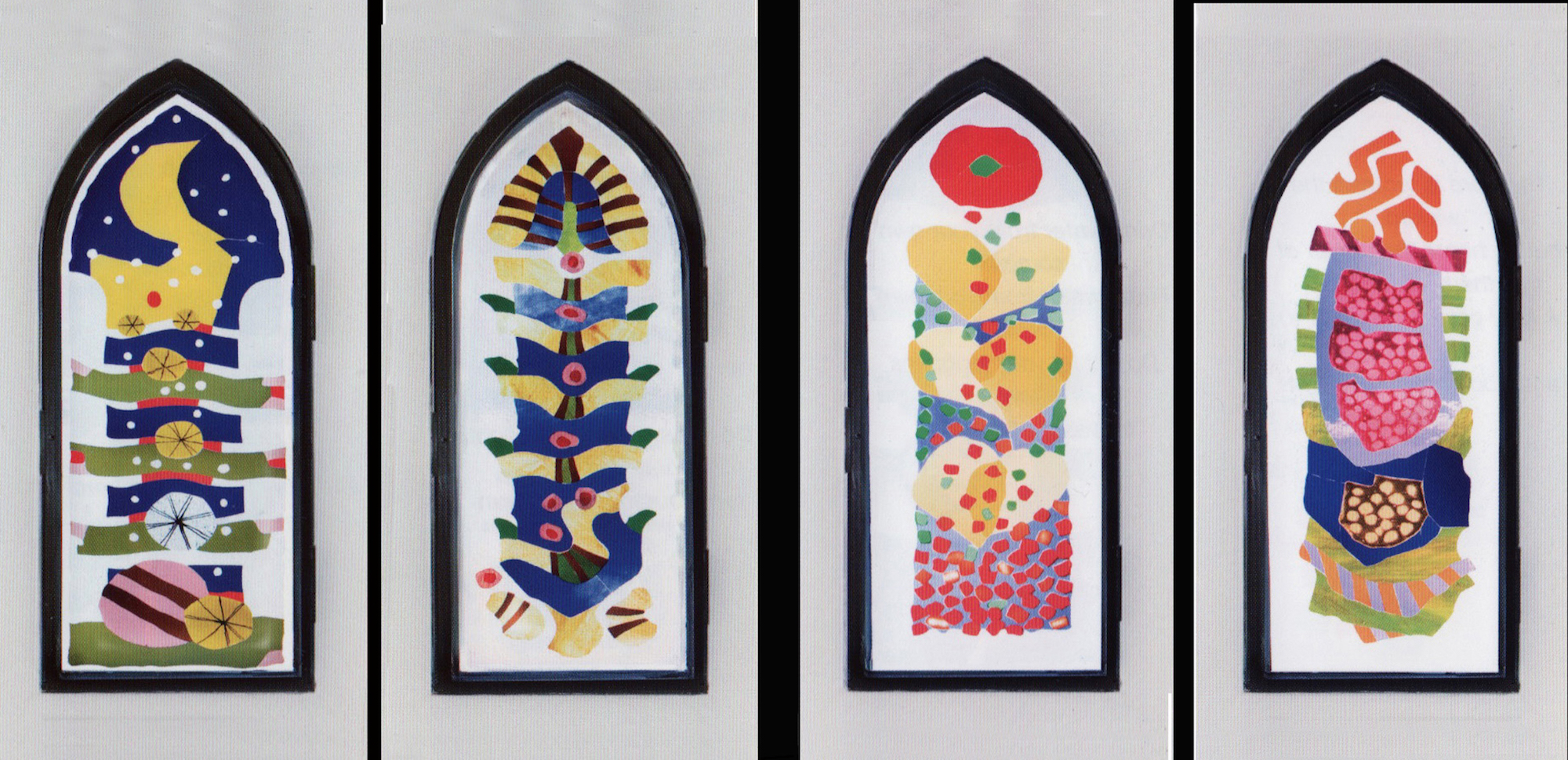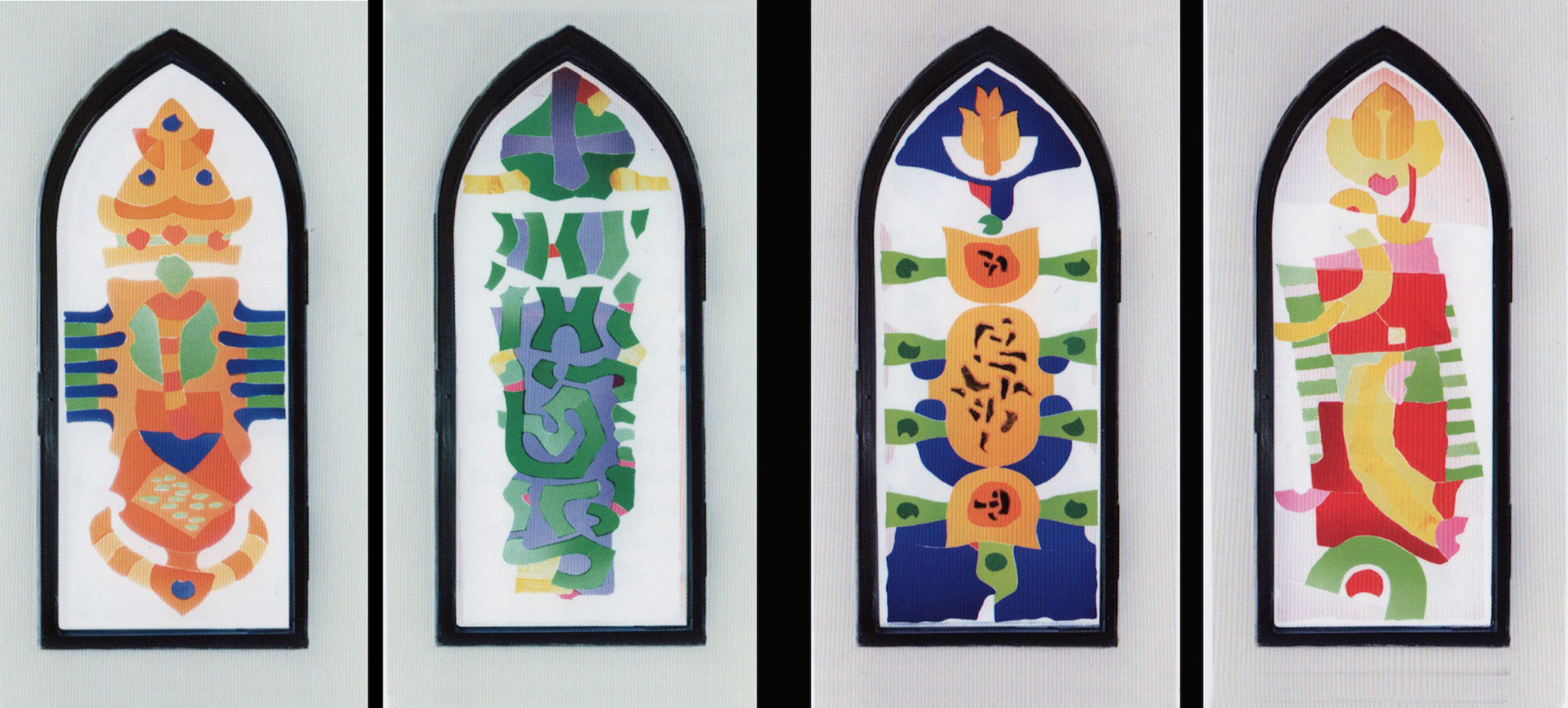22. CHAPEL SOUTH EAST WINDOWS
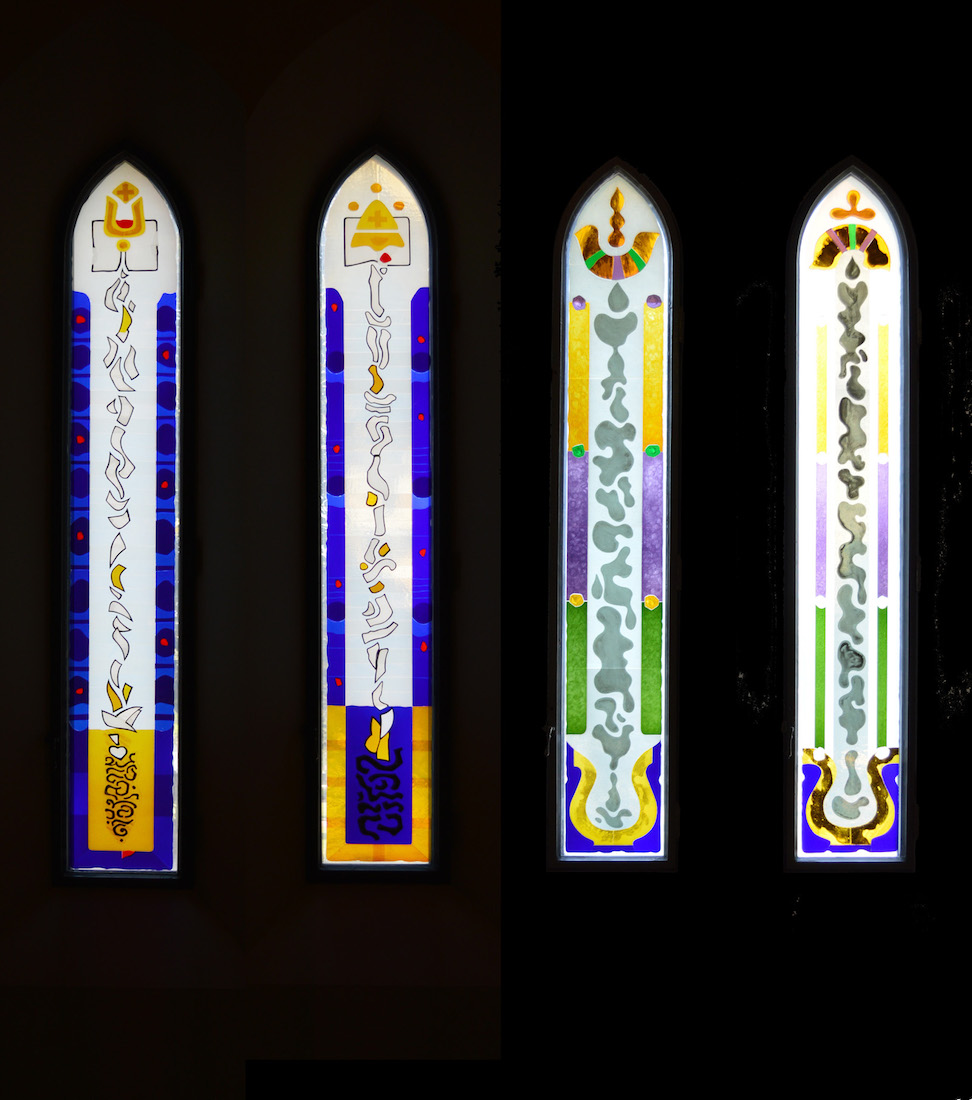
The Oils cabinet is set between two pairs of windows – the Sacred Oils windows shown here at right, and the Baptismal windows at left. We can picture the sacred oils dropping from a heavenly sphere into a golden vessel. The Baptismal windows show the blue water. The left window of the pair represents Infant Baptism, the right, Adult Baptism.
23. OILS
The cabinet of Sacred Oils contains the Oils of Catechumens, Chrism, and the Sick used in the administration of the sacraments.
24. CHAPEL EAST WALL
As we move along this wall of the Chapel from the Oils cabinet, we come to the grey Reconciliation Room.
25. EAST WALL WINDOWS
The windows at left have to do with prayer and healing. They show images of bandages together with the descending Dove of the Holy Spirit. The windows at right are the Paradise, or Garden of Eden, windows. The left window is green and peaceful. The right window with the apple at the top, disturbed.
26. RECONCILIATION IMAGE
Of interest at the grey reconciliation room is this charcoal sketch with the image of Jesus meeting the Samaritan woman at the well, as told in John 4.
27. ST MARY OF THE CROSS
In the north east corner of the Chapel is this smaller but dramatic ‘St Mary of the Cross’ chapel. The statue of Mary MacKillop was designed by Peter Corlett in lost-wax cast bronze. Mary MacKillop was an Australian woman of heroic virtue, proclaimed Blessed in 1995 by Pope John Paul II. She was a mother-type, mentor, teacher and leader who remained steadfast to her faith and God throughout her life, even when temporarily excommunicated.
28. TABERNACLE
The focus at the northern end of the Chapel is the unusual Tabernacle designed by Robin Blau. It symbolizes the heavy seed from which life springs. It is almost like a grain of wheat – symbolic of the Eucharistic elements which are kept in the Tabernacle. When opened up for Eucharistic Adoration, it appears as a small triptych [Cathedral photo]
29. ALTAR WINDOWS
On either side of the tabernacle, and behind, is an altar window. The artist includes these in a set of ‘Sacred Heart’ windows. There are echoes of the terrible 1996 fire here. Fire has always been symbolic not only of destruction but also of love, which burns, fosters, and lights the way. So the windows here glow red with the fire of love and promise. There are in fact 78 windows by Klaus Zimmer in this chapel. Unfortunately, not all are visible to the general public: for example, not shown here are the tower windows, those in the reconciliation rooms, nor those in the sacristy.
30. COFFEY MEMORIAL
Looking towards the back wall behind the tabernacle, the Dean Coffey memorial is visible. Dean Nicholas Coffey died suddenly in November 1857, aged 56. He was an Irish Franciscan priest who arrived in Sydney in 1839. During Fr. Brennan’s absence from the Parramatta Diocese between 1842 & 1847, Dean Coffey was in charge and he later became the Parish Priest of Parramatta in 1852. He remained in this position until his death in 1857. It was Dean Coffey who was responsible for the building of St Brigid’s at Prospect.
31. MADONNA CHAPEL
The Cathedral’s Marian shrine is the Mother of Grace Chapel. The statue, protected by an electronic beam, is a German Madonna, holding the baby Jesus. She stands on a flat plinth with an apple in her hand, and the naked Jesus sits on her left hand, symbolizing the new Adam and the new Eve. Nothing is known of the artist, although the statue’s provenance seems to be Southern Bohemia around 1420.
32. MADONNA WINDOWS
The west windows and north window are structured in pinks, whites, reds and touches of gold, and are dedicated to the Virgin Mary They are designed to flood the space with spiritual lightness.
33. WEST CHAPEL WINDOWS
As we move back into the Chapel, we stand in front of the Redemption Windows. These two windows speak of the Christian understanding of redemption – all are saved through the life, death and resurrection of Jesus Christ. Redemption is about never-ending hope and forgiveness through the action of God. Each window has a symbol of the triune God at top. Below is a carpet on which one can walk upwards towards divinity, towards God. The carpets are covered in indecipherable calligraphy – a reminder of the many languages in the world. Red, the colour of spilt blood is dominant. Gold is for the Spirit.
34. WEST WINDOWS
These windows stand on either side of the entrance to the new Cathedral. The Alpha and Omega windows are a reminder that we have come to worship God the Creator, the Power of Powers, the One without whom there would be no life. The alpha and omega mark the beginning and end of life’s journey. The Commandment Windows give a short clipped version of the Ten Commandments. At the top of each window is a symbol of the all-embracing love of God. Below this is the sea of life, with red for generation, green for hope, blue for eternity. And all around, the starry sky ... .
35. CLERESTORY WINDOWS I
The clerestory windows sit high above the Chapel and are easily missed. Those in the eastern wall illustrate the Psalms. From left we have here: • A child is born, a path of sunshine, the water of life (Psalm 119:73); • Psalm 18:1–2 I love you, O Lord, my strength. The Lord is my rock, my fortress, my deliverer; • Like a child’s happiness – filled with joy! (Psalm 42: 1 – 2); • The family, a garden, flowers, all that is pleasurable, a God who smiles (Psalm 11:1–2).
36. CLERESTORY WINDOWS II
From left • The structure is of a strong vertical shape reaching to God – a family finds its way (Psalm 7:!0). • A wind blows, petals fall, seed pods emerge (Psalm 150:6) • I am looking at the light side of family life – what it can be as a place of friendship and protection and movement. Mauve shapes, like leaves, are floating up. (Psalm 12:6 – 7). • Here are five young people – they dance, they have an eye, they have a head – or are they just plants, desert peas? On top, a medieval helmet; at the bottom, a script that cannot be read – it is a life we all wish for, one with a golden sheen.
37. CLERESTORY WINDOWS III
From left: • Psalm 70:4,5 Let all who seek you rejoice and be glad in you. Let those who love your salvation say evermore, “God is great!” • Two dominant shapes: one is moving upwards – the green snaky thing; the other is like a sickle or the head of an opening plant; and within that, this golden cross. ( Psalm 6:2,4). • To me this is a walk through the meadows, with all the flowers in bloom. On the top is a flower, a poppy; a mauve flower, yes; and this is my red flower. They are full of heart, full of blessing, full of exuberance, full of earth, full of colour. (Psalm 70:4) • The red cross: it can have meaning, but it doesn't have to ... ( Psalm 109:30–31).
38. CLERESTORY WINDOWS IV
We now look at the western (Proverbs) windows. From left: • Do not let loyalty and faithfulness forsake you; bind them around your neck, write them on the tablet of your heart (Proverbs 3:3). • Here is a fountain within a rectangle of gold. Anywhere where you have gold or fertilized earth, things that are growing must generate fruit. There is a disciplined rhythm here. (Proverbs 8:16). • Follow the form and you can see a fish in the net with a red tail. But it is also like a bomb in the net; it’s a warning. Proverbs 15:16). • This makes me laugh, this audacious shape like a wedding cake – all those layers. (Proverbs 4:26–27).
39. CLERESTORY WINDOWS V
From left • Here is the moon and here the stars which you can pluck from the heavens ... and perhaps a child’s pram with wheels like balls; it’s a child’s playground. (Proverbs 7:1–2). • Some give freely, yet grow all the richer; others withhold what is due, and only suffer want. A generous person will be enriched, and one who gives water will get water. (Proverbs 11:24–25). • A soft answer turns away wrath, but a harsh word stirs up anger. The tongue that soothes is a tree of life, the barbed tongue a breaker of hearts. (Proverbs 15:1–4). • Joy and celebration – a summer garden filled with luminous colour.
40. CLERESTORY WINDOWS VI
From left to right: • Drink water from your own source, fresh water from your own well. Do not let your fountains flow to waste elsewhere. (Proverbs 5:15–16). • The Lord is far from the wicked, but he hears the prayer of the righteous. A kind glance gives joy to the heart, and good news refreshes the body (Proverbs 15:29–30). • A tree of life comes out of a mystical blue ground; on top a tulip shape in a half circle of light; on each side leaf shapes to green the tree; and on top is the red for the blood of Christ – that is why we are here. • My mouth proclaims the truth, wickedness is hateful to my lips – all the words I say are right ... ... (Proverbs 8:7–8)




